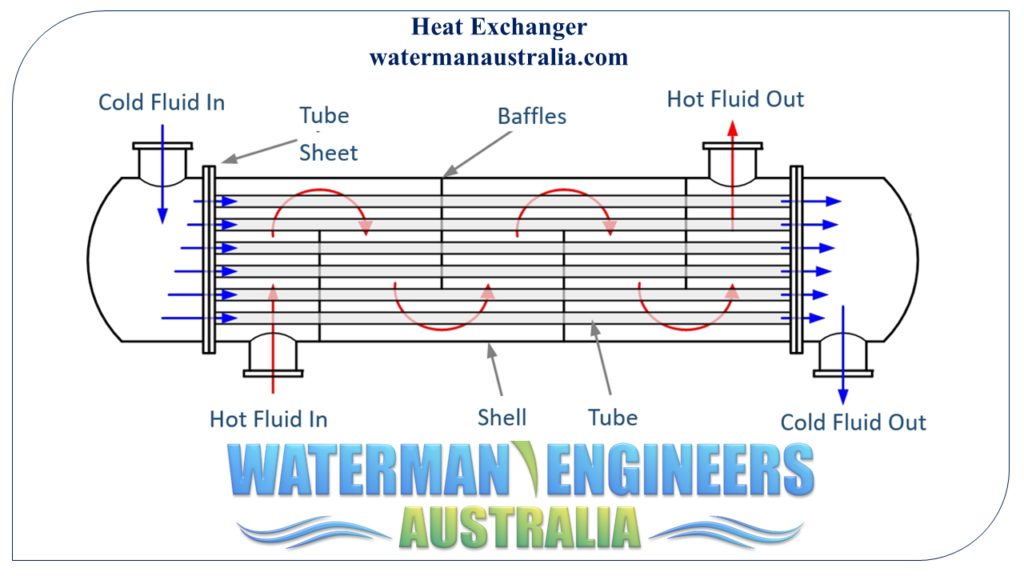
A heat exchanger is a device that allows for the transmission of heat between two different media without any physical contact between them. Heat exchangers work on the idea that thermal energy can be transferred from a hot fluid to a cold fluid. Heat exchangers provide for precise temperature regulation, improving energy efficiency and system functionality by transferring heat between two fluids.
Power plants, chemical plants, HVAC (heating, ventilation, and air conditioning) systems, supermarkets, and many more all employ heat exchangers. They can be found in commonplace home products like air conditioners and water heaters.
In this article, we'll learn about heat exchangers, what they are, how they work, and the different kinds there are. The article also details the common uses and factors to consider when choosing a heat exchanger.
In counter stream, the cold and warm fluids enter the heat exchanger at reverse stop and move in opposite direction, as demonstrated in Determine two.
In truth the mechanical style have to be carried out to determine the gear excess weight, the posture of supports and also that of nozzles, which is determined by the thickness of flanges, positions of welds, etc.
Subcoolers are added heat exchangers that assist Enhance the effectiveness within your refrigeration method by cooling the refrigerant even more right before it enters the evaporator. Listed here are the principle kinds of subcoolers:
Along with the Main, the device is made up of an insulated container, defrost controls to circumvent dampness freezing within the Main and fans to move the air. All heat exchangers need insulation to increase effectiveness and reduce condensation development on the skin on the unit.
Two kinds of circulation arrangement are possible in the double-pipe heat exchanger: parallel move and counter circulation. In parallel flow, both equally the hot and cold fluids enter the heat exchanger at the exact same finish and go in exactly the same path, as demonstrated in Determine 1.
If the exchanger form and measurement are recognized and also the fluid outlet temperatures need to be decided, the applying is generally known as a efficiency calculation dilemma. These kinds of complications are finest analysed because of the NTU-efficiency process [4, five].
The overall ideas on the mechanical style of the subsequent forms of exchangers are offered within the
Condensers are the recent part of one's fridge, answerable for releasing heat through the refrigerant and turning it back into a liquid. Allow’s Have a look at the differing types of condensers:
Part failures in heat exchangers can lead to a complete breakdown of your refrigeration method. Leads to can include producing defects, put on and tear, or inappropriate routine maintenance. Standard inspections and good routine maintenance might help determine and stop potential failures.
These fluids tend to be divided by some form of heat transfer surface, no matter whether of the tubular, flat plate or finned style and design. Heat exchangers are frequently categorised In accordance with their building, compactness and how they transfer the heat from the principal to your secondary fluids.
Air cooled heat exchangers are An additional sort of exchanger style and design present in automotive programs to cool the engine.
The existing paper employs monitoring information and delivers an in depth quantitative Investigation of the performance of a large-diameter EAHX designed for standalone cooling of the present office making. The sphere checking was carried out all through a attribute scorching and dry Designing of heat exchanger manufacturer summer period of the south of Portugal. Results show that out of doors air to EAHX exit air temperature gradients achieve nine K and cooling capacities exceed 27 kW. Moreover, the researched EAHX is capable of standalone cooling for outdoor air temperatures as many as 33 °C and meets more than fifty% from the space layout cooling demand from customers for outdoor air temperatures as high as 37 °C. This evidences that giant-diameter EAHXs provide the prospective to achieve significant reductions in CO
If the influence aspect exceeds the TEMA limits, impingement safety is necessary. The TEMA benchmarks specify various rho-v-2 limitations for erosive fluids and nonerosive fluids.
Fundamentals of Heat Exchanger Style and design is perfect for training engineers, in addition to for Sophisticated undergraduate and graduate students in mechanical and aerospace engineering, Electrical power engineering, and linked subjects.